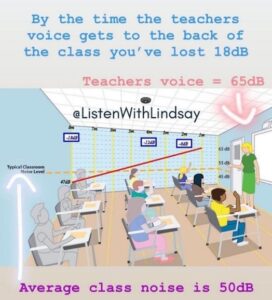The classroom can sound like a bustling jungle! All those noises can turn our learning adventures into challenging quests for our little explorers. But fear not! We know how vital it is to create the perfect learning habitat for our young adventurers.
Now, let’s uncover the three sneaky culprits making it hard to hear in our classroom jungle: background noise, the distance between the speaker and the listener, and the pesky reverberation or echo.
Did you know that the average noise level in our classroom jungle is around 50dB? That’s as loud as a chatty parrot! And just like exploring the jungle, getting up close to our speaker can make their voice sound crystal clear. But alas, that’s not always possible. The further away you go, the quieter their voice becomes, and the louder the background noise gets. It’s like trying to hear a whispering monkey amidst the jungle’s roar! Sitting way in the back of the class could mean missing out on up to 18dB of hearing fun!

What exactly is this Signal-to-Noise Ratio (SNR) all about?
Well, think of it as the ultimate DJ of the auditory jungle – it’s like the master mixer, measuring how clearly the desired signal (think of the teacher’s voice) stands out against the background noise (imagine chatty classmates, rustling papers, and buzzing fluorescent lights). A higher SNR means the signal shines through the noise, crystal clear and easy to groove to.
So why does SNR matter in our classroom jungle?
Picture yourself trying to have a chat at a wild party – quite the challenge, isn’t it? Now, transport that scene to the classroom, where students are navigating through new knowledge, discussions, and instructions amidst a cacophony of distractions. A good SNR ensures that the teacher’s voice cuts through the jungle din, creating a clear path for learning adventures.
Now, let’s swing into the benefits of a good SNR:
- Enhanced Comprehension: When the teacher’s voice rings loud and clear, students grasp instructions, explanations, and concepts with ease, leading to better understanding and memory retention.
- Increased Engagement: Clear communication ignites enthusiasm among students, inspiring them to dive into discussions, pose questions, and join class activities with gusto.
- Reduced Fatigue: Struggling to hear over the jungle racket can drain mental energy. By optimizing the SNR, students conserve their focus and stamina, resulting in less fatigue and sharper concentration.
- Inclusive Learning: A solid SNR levels the playing field for all students, including those with hearing challenges, ensuring everyone can access educational content and thrive in a supportive environment.
In the end, as educators and guardians of the jungle, it’s our duty to ensure every student can explore and thrive in our classroom ecosystem. By making SNR a priority, we create a jungle where clarity reigns supreme, distractions fade into the background, and every voice can be heard loud and clear. So, let’s crank up the volume on learning and blaze the trail to academic success – one clear signal at a time!
Don’t miss out on our upcoming blog about mastering the jungle like Tarzan and harnessing FM systems to boost the Signal-to-Noise ratio!






